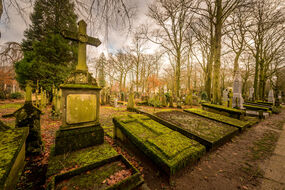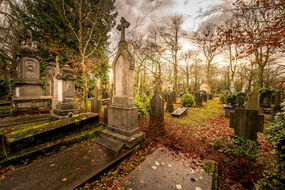Centrale Begraafplaats Assebroek (Main cemetery at Assebroek)
This mysterious burial ground is not only the oldest in Belgium, it is also a wonderful place of silence within walking distance of the city centre. Prominent Bruges figures from the arts, literature, politics or nobility have been given their final resting place here.
Cemetery since 1787
At the end of the 18th century, Emperor Joseph II ordered an end to the centuries-old tradition of burying people around the churches. Graveyards had to be removed from the city, well outside the city walls, because hygiene and public health took priority. The Bruges city council promptly bought a plot of land in Assebroek. The first burial took place in 1787 and from 1810 onwards, all inhabitants of Bruges were buried here.
Contemplative atmosphere
Access the cemetery via the beautiful gatehouse. The peace and quiet, along with the overwhelming greenery, are bound to slow down your heartbeat. Just have a wander around. Notice the ancient beech trees, some of which are more than 200 years old. In the 19th century, an imposing grave monument was a status symbol for the well-heeled. Keeping up appearances for eternity. Many gravestones and tombstones are the product of the creative minds of high-profile sculptors. Enjoy the melancholic splendour that can be found in abundance.
Prominent Bruges
On Bruges' Père-Lachaise, you will find, among others, the graves of the famous city architect Louis Delacenserie, the poet Guido Gezelle and the Brit James Weale, known for his research on the Flemish Primitives. The souls of many other artists, architects and historians also find everlasting refuge here.
From 2 to 12 hectares
Compared to 1787, the cemetery is now much larger. At a certain point in time, plots were added for members of the clergy, such as Jesuits and beguinage nuns. The British, who were present in large numbers in the city in the 19th century, were also allocated a place here. A sizeable proportion of the cemetery has been occupied by war graves since the First World War. This is the final resting place of Belgian, British and German soldiers and civilians who lost their lives in the war. The most recent expansion accommodates a columbarium with a scattering area and urn tombstones.
Valuable heritage
A remarkable building near the entrance houses a small exhibition about the beautiful heritage, folklore, art and architecture. Admire the typical grave symbols. The hourglass as a symbol of the passing of time. Or the dove, the snakes or the skull. Together they tell a tale of hope, fear or love.
Living cemetery
These days, the Stedelijke Commissie voor Graftekens (Municipal Shrines Commission) advises the city on the management and restoration of the cemetery. Bruges has been a pioneer in the repurposing of graves, i.e. the reuse of old grave monuments, since the 1980s. The graves are being cleared, but the city also encourages the preservation and restoration of historic and monumental tombs. This means that ancient tombs are retained.

Exclusively for UK residents: Book a stay of at least 2 nights in Bruges and enjoy the exclusive free Best of Bruges Deal worth 50 euros!
Read more >
Time information
from 01-04-2021 to 15-10-2021| Monday | 08:00 - 18:00 h |
|---|---|
| Tuesday | 08:00 - 18:00 h |
| Wednesday | 08:00 - 18:00 h |
| Thursday | 08:00 - 18:00 h |
| Friday | 08:00 - 18:00 h |
| Saturday | 08:00 - 18:00 h |
| Sunday | 08:00 - 18:00 h |
| Monday | 08:00 - 17:00 h |
|---|---|
| Tuesday | 08:00 - 17:00 h |
| Wednesday | 08:00 - 17:00 h |
| Thursday | 08:00 - 17:00 h |
| Friday | 08:00 - 17:00 h |
| Saturday | 08:00 - 17:00 h |
| Sunday | 08:00 - 17:00 h |
| Monday | 08:00 - 18:00 h |
|---|---|
| Tuesday | 08:00 - 18:00 h |
| Wednesday | 08:00 - 18:00 h |
| Thursday | 08:00 - 18:00 h |
| Friday | 08:00 - 18:00 h |
| Saturday | 08:00 - 18:00 h |
| Sunday | 08:00 - 18:00 h |








